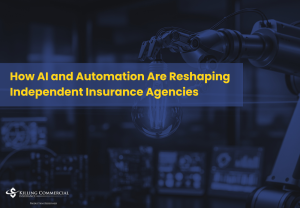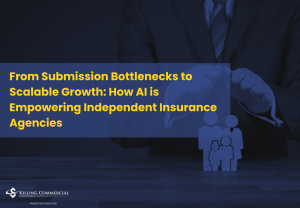Proven Strategies for Building a Strong Remote Team: Using Job Descriptions, KPIs, and Core Values to Drive Accountability and Growth

As commercial insurance agencies scale, especially in the middle-market space, the producer mindset that got the business off the ground often becomes the very thing that holds it back. Most agency owners start out as salespeople—laser-focused on closing deals, not writing job descriptions. But when your team starts to grow, particularly in a remote or hybrid environment, clarity is no longer a luxury—it’s a requirement.
In this post, we’re going to walk through how clear, actionable job descriptions—when aligned with key performance indicators (KPIs) and core values—can become your agency’s most powerful tools for building a high-performing team, improving internal communication, and accelerating agency growth.
Why Job Descriptions Matter More Than Ever in Remote Work
In a traditional office setting, employees might naturally absorb some expectations just by being present listening to others, seeing how things are done, or jumping in when someone needs help. But when your team is remote, those cues disappear. That’s when poorly defined roles cause the infamous, “Well, that’s not my job,” scenario.
Here’s the reality: if your team doesn’t have written job descriptions, they’re guessing every day about what success looks like. That’s not a performance issue—it’s a leadership one.
Many agency owners confuse managing with leading. A manager assigns tasks and oversees execution. A leader sets the vision, defines expectations, and empowers the team with the tools to win. In remote settings, your first leadership tool is a strong, well-crafted job description.
Laying the Foundation: Start with the Organizational Chart
Before you can write clear job descriptions, you need to know how your agency is structured. That starts with a clean, defined organizational chart. This exercise helps you clarify:
- Which roles you currently have
- Which roles you need
- Where there may be overlap or gaps
- How responsibilities flow between departments
In many agencies, the lines between service and sales can get blurry. One person might be closing deals and handling renewals, or “wearing too many hats” in a way that causes friction and burnout. When you define your org chart first, you give every role its place and purpose, which becomes the framework for every job description to follow.
Connecting the Dots: Job Descriptions and KPIs

One of the most impactful takeaways from our recent discussions with agency leaders is this: “Job descriptions are KPIs spelled out.”
This perspective reframes the job description from being a dusty HR document to becoming a tactical performance blueprint. It’s not about listing tasks. It’s about showing what success looks like in a role.
Let’s say you’re hiring a new commercial producer. It’s one thing to say:
“Responsible for managing the sales process.”
That might make sense to you—but to the new hire? It’s vague. Instead, define it in bullet points like:
- Respond to all new leads within 30 seconds
- Log all prospect interactions in the CRM within 1 hour
- Provide a minimum of 3 quote options to every qualified prospect
- Maintain a weekly close ratio of 30% or higher
When you define a role by specific actions tied to measurable KPIs, two things happen:
- The employee knows exactly what’s expected of them.
- You now have a performance standard you can coach to, measure, and reward.
Need help designing your KPIs? Check out our KPI creation worksheet to get started.
Using Job Descriptions as a Hiring & Culture Filter
One of the smartest things you can do before extending a job offer is to show the candidate their actual job description—not the polished, promotional version, but the real one.
Why? Because job descriptions should be a reflection of your agency culture and daily expectations. If someone balks at the idea of calling leads in under 30 seconds or doesn’t align with your sales process, wouldn’t you rather know that now?
This strategy acts as a two-way filter:
- You avoid hiring someone who’s a bad fit for the role or agency.
- The candidate gets a transparent look at what the job really involves.
This isn’t about weeding out “bad people”—it’s about identifying who fits your team’s rhythm and values. As many agencies know, keeping someone around just because they’re “nice” can be costly in the long run if they’re not aligned with your performance standards.
Embedding Core Values into Every Role
A job description without core values is just a checklist. When you embed your agency’s values—like “Compete Relentlessly,” “Act with Compassion,” or “Win as a Team”—into the description, the job becomes a mission.
For example, if a core value is “Clarity,” that’s your opportunity to tie every communication task—CRM notes, client follow-ups, internal handoffs—back to that value. It transforms a “duty” into a purpose.
Too often, agencies say they want a values-driven culture, but don’t reinforce those values in the day-to-day. Job descriptions are the perfect place to start. It’s where you translate your culture into expectations, and then back those expectations up with real accountability.
Need a refresher on how to create or reinforce your agency’s core values? Our Core Values Worksheet walks you through it.
Boosting Motivation with Personal Goal Alignment

Here’s a game-changer: tie your employees’ personal goals to their job descriptions and KPIs.
Let’s say someone joins your agency as a producer, but eventually wants to become a sales manager. Instead of keeping that goal in a drawer, use it as a motivational tool. Their job description becomes not just a list of duties—it becomes their path to advancement.
For example, if management is only considered for those who hit a certain close ratio, generate a specific volume of new business, and mentor others on the team, then the employee can see clearly what milestones they need to hit.
This creates a direct alignment between:
- What the agency needs
- What the employee wants
- How the role is structured to support both
When people understand how today’s performance connects to tomorrow’s opportunity, they’re far more engaged, accountable, and proactive.
Actionable Takeaways for Agency Owners
You don’t have to reinvent the wheel to improve your agency’s structure and performance. Here’s a quick-start list of what you can do this week:
- List every task that needs to be done in your agency.
- Group those tasks into logical roles (sales, service, marketing, etc.).
- Define KPIs for each role that show what “winning” looks like.
- Build job descriptions around those KPIs, using bullet points, not fluff.
- Tie each task back to your agency’s core values—explain the why, not just the what.
- Share job descriptions before hiring—no surprises, no mismatched expectations.
- Use personal goal alignment to create motivation pathways inside the agency.
- Reinforce job descriptions in 1:1s, reviews, and training—don’t let them collect dust.
Remember: job descriptions aren’t just for HR—they’re for leadership, clarity, accountability, and culture.
Resources to Help You Get Started
We know building out a full set of custom job descriptions can feel overwhelming, especially when you’re still in the trenches of selling, servicing, and scaling.
That’s why we’re sharing a set of practical tools you can access on our website:
A sample job description you can adapt for your agency roles
A job description creation worksheet that walks you through the process
A KPI guide for remote teams
Access to our weekly newsletter with tips, tools, and strategies for agency leadership
Make sure to sign up for the newsletter while you’re there. We only send one per week, packed with actionable insight—and occasionally we’ll surprise you with some industry swag or giveaways to thank you for implementing what we teach.
Final Thoughts: Job Descriptions Are Your Leadership Tool
Your team can’t hit a target they can’t see. In the remote age, that’s more true than ever.
Clear job descriptions, built around specific KPIs and reinforced by core values, are how you lead at scale. They allow you to coach better, hire smarter, and build a culture where everyone knows their role and how to win in it.
More importantly, they help you transition from being just a producer who owns an agency—to becoming a true leader of a business that scales with intention.
Start small. Pick one role. Define the success metrics. Add your core values. Build from there.
If you want help, we’ve got your back.

How AI and Automation Are Reshaping Independent Insurance Agencies
In an industry where tradition often outweighs innovation, artificial intelligence and automation are slowly but steadily reshaping how independent insurance agencies operate. The push toward smarter, more efficient workflows is no longer a matter of if—but when. While many agencies are still evaluating how AI fits into their operations, early adopters are already reaping the benefits of streamlined submissions, faster processing, and actionable data insights.

Coaching, Competition, and Consolidation: Inside the Protege Mindset That’s Reshaping the Future of Insurance Producers
The commercial insurance industry is changing faster than ever—and not always for the better. Consolidation is accelerating. Service levels are declining. Private equity is pushing agencies to scale in ways that strip out the personal touch that once defined the independent channel. But for the producers willing to do the work, lean into mentorship, and sharpen their craft, this isn’t a challenge—it’s an opportunity.

From Submission Bottlenecks to Scalable Growth: How AI is Empowering Independent Insurance Agencies
The commercial insurance industry is in the midst of a major evolution. The traditional workflows that once drove agency productivity are now dragging down growth, overloading staff, and frustrating owners who are trying to scale efficiently. For independent insurance agencies—especially those in the middle market—adapting to these challenges without increasing overhead is a tightrope walk.

The Power of Patient Prospecting: How Education, Niching, and Mindset Drive Middle-Market Success
Few industries reward consistency, discipline, and patience quite like middle-market commercial insurance. Initially, every producer starts with a different story, background, and path into the business. However, the ones who rise are the ones who learn to embrace the long game. Moreover, while success may take time, those who persevere ultimately reap the benefits. Furthermore, this industry values resilience, and those who remain committed often find themselves achieving great success in the end.

Reclaiming Purpose in a Distracted World: Empowerment, Emotional Intelligence, and the Future of Work-Life Balance
In today’s performance-obsessed culture, achieving elite status in your profession can often come with a hidden price. Tania Khazaal, known to many as Tanya the Herbalist, knows this truth firsthand. After climbing the ranks in the insurance industry and landing in the top 1% of sales professionals, she found herself at a crossroads. Despite the accolades, international travel perks, and consistent recognition, she was suffering from a quiet crisis: burnout.

From Confusion to Clarity: How Insurance Agencies Can Unlock Growth Through Strategic Leadership and Culture
In the fast-paced world of commercial insurance, the grind of daily operations often blinds agency leaders to the foundational cracks forming beneath them. Producers are focused on closing deals. Account managers are buried in servicing. Agency principals are juggling leadership, sales, operations, and finance. Yet in the midst of this hustle, many agencies lack the one thing that can unlock the next level of growth: organizational clarity.

Responses